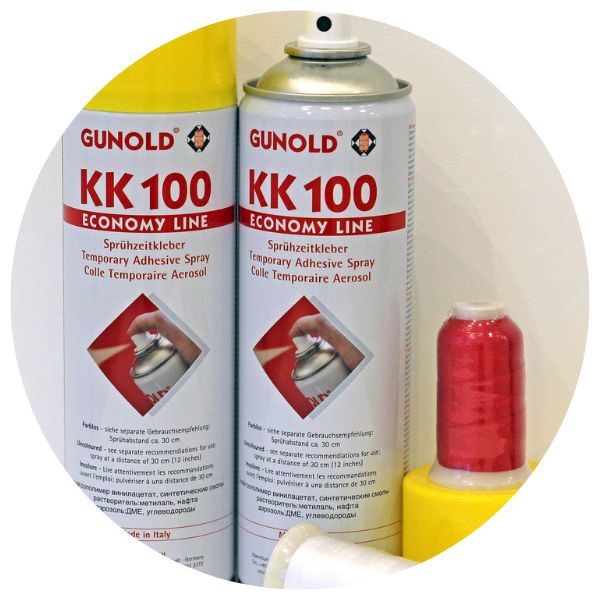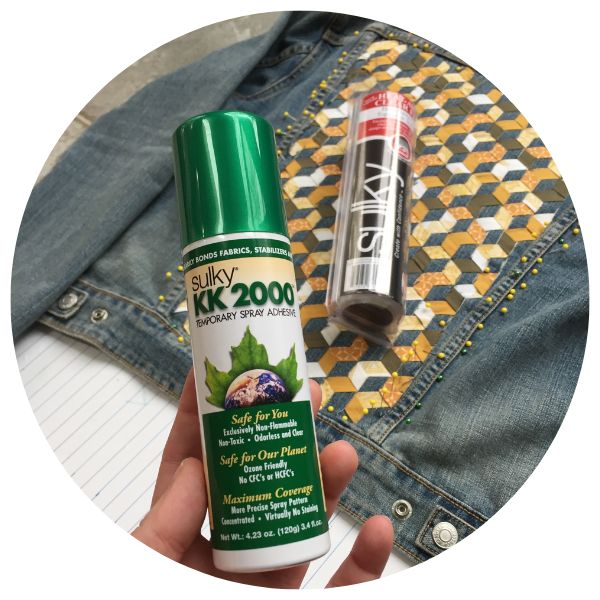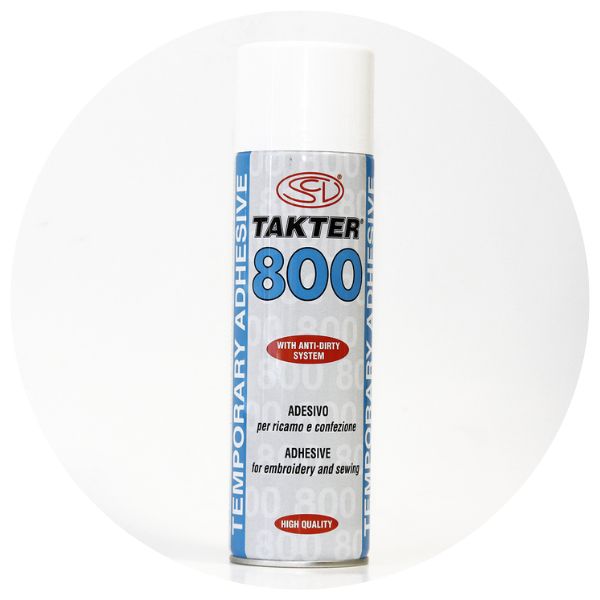Perfect results in embroidery depend on four parts: a flawless combination of fabric and stabilizer, an impeccable design, good quality threads, and a sound embroidery machine. In our aspiration to help you achieve only perfect results in your work, we’ve created a series of articles dedicated to the abovementioned quartet. Some of them, like how to find clients for embroidery and the real cost of embroidery unveiling the true expenses, have already been covered. You can find them in our older posts. Others, like the one concerning machine embroidery designs per se, are in the process of making, so you might want to keep an eye on our updates. Today, we’d like to continue with the theme of stabilizers, furthering it in more detail.
In particular we’ll speak about a “kind of stabilizer” called temporary adhesive spray, where to use it and so on.
Every embroiderer inevitably stumbles upon little bumps and crinkles their work that despite the small caliber takes tons of time to get right and “even”. And we mean – literally… You may have the widest selection of stabilizers. Your arrays of hoops of all shapes and sizes might be really impressive. Still, there’s a chance that you find yourself in a hold-up of some sort or another. And in some of them the best and easiest way out is using a temporary spray adhesive. This truly magical helper of every embroiderer offers an effortless solution for many common embroidery hitches associated with extra stabilization. So, let’s talk about the theme in detail.
When do you need temporary adhesive and do you actually need it all?
To answer this question, go through the embroidery projects you’ve already accomplished and tap their most difficult highlights. Have you ever been tired of shifting and displacing layers in stabilizer-fabric sandwiches? Has distortion of fibers in stretchy fabrics while hooping or embroidering ever made you bummed out? How have you dealt with the “un-shoppable” fabrics and projects? What about the puckering of the material around and within the embroidery and oh-so-very tedious basting process? Who hasn’t met all those frustrating catches and setbacks at times? Most of us have! If you still haven’t, save time, stress, and money that otherwise would have gone wasted in destroyed projects, and get yourself a temporary adhesive spray for embroidery.
But don’t just rush to the nearest craft store to get any spray with temporary fabric glue in its formula. Stitching art is diverse, including quilting, sewing, embroidery, and adhesive sprays. Before buying, you need to know that even though some sprays might seem alike, they still differ. Some have longer bonds than others, which is good for quilting but might not be suitable for other kinds of work. Some adhesives are perfect for tracing templates onto the fabric but might cause gumming of needles in machine embroidery. There’s also a difference in the thickness of the formula, which might vary from the finest mist to a heavier feel and tack.
These are general things you must remember when buying a temporary spray adhesive for your embroidery work. A bit later, we’ll discuss some of the actual products available on the market in a more detailed form. Before we dwell further, however, we’ll briefly introduce the theme, explaining the general rules of their use. Understanding these rules dramatically helps you decide on the temporary adhesive spray.
General rules of temporary spray adhesive use:
1. Temporary adhesive spray for embroidery is applied not on the fabric, but on stabilizer. In case you are dealing with appliqué, the spray is applied on the piece you’ll be stitching to the main fabric.
2. Always keep the distance (specified in instructions written on the bottle), from which the spray should be applied. This measure will help you avoid unwanted stains, caused by the uneven distribution of the spray.
3. After the temporary adhesive is applied wait a few seconds before tacking the pieces together. Each manufacturer has its own preferences as to the timing.
4. No matter how harmless and eco-friendly the composition of the adhesive formula is, never apply it near your embroidery machine or computer. The incidental overspray might cause damage to the hardware of your equipment. To protect your equipment you might want to use the so-called embroidery spray box, a.k.a. a plain shoebox or other cupboard boxes. Mind that their sides should be high enough to contain the overspray. For hoops, there’re tons of DIY variants of shields on the Internet.
5. Before each new use of the spray try its quality on a small piece of fabric. Specifically, this rule must be applied if you’re dealing with fabrics of delicate character. This measure will help you avoid possible staining if the spray is not compatible with the fabric or simply has gone off.
6. Quilting and basting temporary adhesives might have a longer bond than those for embroidery and appliqué.
7. Most of temporary aerosol adhesives don’t saturate fabrics and stabilizers, forming kind of a fine sticky layer which dissipates after its bonding time expires. If that is the case with the one that you’ve got, then there’s no need to wash or iron the sprayed-on project. Otherwise to remove remnants of the spray washing or ironing is required.
8. When buying a temporary spray adhesive, it’s worth getting also a proper cleaning product both for the embroidery machine hardware (think hoops) and the fabrics. Things happen and you’ll be glad you did when a stain appears in the most inconvenient time.
9. Always check the expiration date, for an expired product might leave stains on your fabrics.
So, now that you’ve covered the general information, let’s get down to the particular products.

Temporary adhesive spray KK 100 Gunold
This yellow-capped bottle is one of the most widely used temporary adhesive sprays. It is available in bottles of “Economy” and “Original” variants. Both are claimed to have the same temporary adhesive formula in their content but with various concentration levels. The “Economy” is a less concentrated one. This particular product is used for multiple tasks, some of which include:
– temporary stabilization of small “un-hoop-able” fabric details during embroidery;
– temporary adhesion of appliqués, so that it would be safer and easier to further stitch them on the main fabric;
– temporary adhesion of cut-away and tear-away backing stabilizers to stretchy fabrics to avoid shifting of the layers and/or distortion of their fibers under the pressure of the embroidery needle;
– temporary adhesion of upper stabilizers, used for delicate fabrics.
KK 100 Gunold doesn’t contain water, which makes it very useful when working with water-soluble stabilizers (think Solvy etc.). It has a good bond, which allows effortless stitching and thread changing without pulling away the fabric. The bond dissipates fairly quickly (usually within 24 hours, depending on the humidity of your area) without leaving any residue or stain.
This yellow-capped bottle is one of the most widely used temporary adhesive sprays. It is available in bottles of “Economy” and “Original” variants. Both are claimed to have same temporarily adhesive formula in their content, but with various levels of concentration. The “Economy” is an, obviously, less concentrated one. This particular product is used for various tasks, some of which include:
– temporary stabilization of small “un-hoop-able” fabric details during embroidery;
– temporary adhesion of appliqués, so that it would be safer and easier to further stitch them on the main fabric;
– temporary adhesion of cut-away and tear-away backing stabilizers to stretchy fabrics to avoid shifting of the layers and/or distortion of their fibers under the pressure of the embroidery needle;
– temporary adhesion of upper stabilizers, used for delicate fabrics.
KK 100 Gunold doesn’t contain water, which makes it very useful when working with water-soluble stabilizers (think Solvy etc.). It has a good bond, which allows effortless stitching and thread changing without pulling away the fabric. The bond dissipates fairly quickly (usually within 24 hours, depending on the humidity of your area) without leaving any residue or stain.
Odif USA 505 Spray and Fix Temporary Fabric Adhesive
Odif USA 505 Spray and Fix Temporary Fabric Adhesive is another good representative of its category. Its manufacturer promises no odor, which is helpful when working in small rooms. Its formula allows repositioning, which is a good advantage, when you’re working on the placement and embroidering of appliqués. It doesn’t gum up your needle. As it won’t drench into the fabric one should spray the product very lightly. Otherwise you risk having to deal with a sticky residue building up on the surface of the working area of your fabric.
It’s worth pairing Odif 505 Spray and Fix with DK5 Adhesive cleaner. They are of the same manufacture and that is almost always a guarantee for good cleaning results. Mind, that DK5 Adhesive cleaner helps you with the 505 build-up on the hardware (think hoops), but not the fabrics.
Tempo spray adhesive. This product is promised to not gum up needles, scissors and other hardware. Its formula is very much alike to that of Odif’s 505 Spay and Fix, so it’s possible to substitute the two of them.

Sulky KK 2000 Temporary Spray Adhesive
Sulky KK 2000 Temporary Spray Adhesive is clear aerosol temporary glue for fabrics. It is odorless and doesn’t leave stains on the fabric. It won’t gum up embroidery needles, which is always a good thing. When working with this adhesive you’ll be able to reposition layers of stabilizers and fabrics if needed. Just like with KK100 Gunold its bond won’t last for long. Keep it in mind when choosing this spray for your projects. When working on larger areas, like in quilt-making, you might need to have a more long-lasting bond.

Takter 650 and Takter 800
Takter 650 and Takter 800 is a nice spray adhesive, created in two variants for a reason. Takter 650 is used for fabrics of a lighter type, while its stronger brother Takter 800 “tacks” heavier fabrics. Both allow repositioning while keeping the bond fairly well.
Dritz Spray Adhesive is a favorite of many embroiderers. Good for quilting, appliqué, and embroidery per se, it doesn’t gum up your needle. On the downsize it is extremely flammable, so be careful when storing and using the product.
Those mentioned above, temporary adhesive sprays have a good history and many fans among embroidery artists. However, it doesn’t mean that there’re no other products with similar qualities. There’s no general rule of thumb, in this case, so you may need to try several products before you come up with your favorite one. The only thing that you need to listen to is your own experience.
Now, what with the questions you ask on the topic in your e-mails. Experience that we have shown that KK 100 Gunold suits our needs perfectly. All our embroidery designs are tried out with the help of this particular product, and the results are always positive. When combined with tear-away stabilizers, we use KK 100 Gunold as extra support to the fabric. In combinations like these, we’ve never experienced any distortion of the fabric fibers or puckering of the material around the embroidery pattern. Go by our experience or create your own; it’s really up to only you. Whichever of the cases you choose, always work with good quality material only and don’t forget to have fun. Because where there’s joy in the work, the results are always great!

Author: Ludmila Konovalova
My name is Ludmila Konovalova, and I lead Royal Present Embroidery. Embroidery for me is more than a profession; it is a legacy of my Ukrainian and Bulgarian heritage, where every woman in my family was a virtuoso in cross-stitch and smooth stitching. This art, passed down through generations, is part of my soul and a symbol of national pride.
Date: 15.02.2018


 Get Sign-In Link
Get Sign-In Link Login with Google
Login with Google Login with Facebook
Login with Facebook Login with Amazon
Login with Amazon Login with Paypal
Login with Paypal